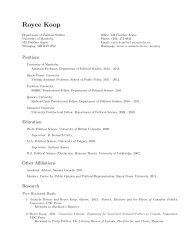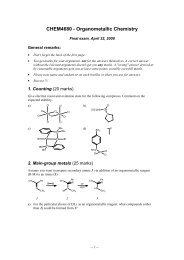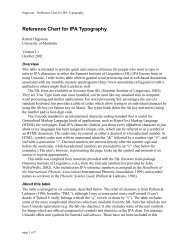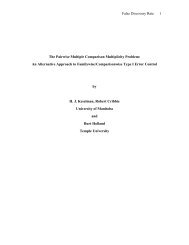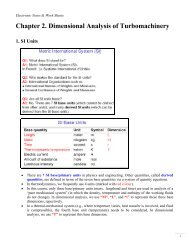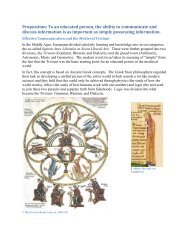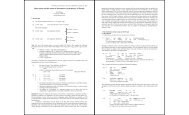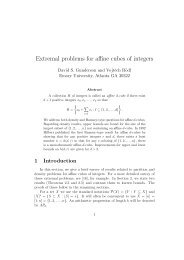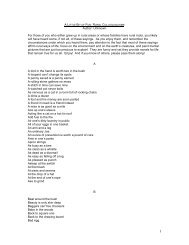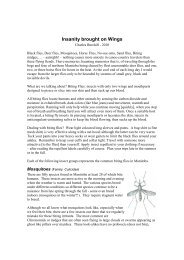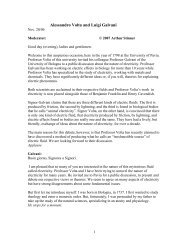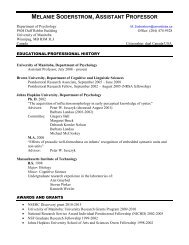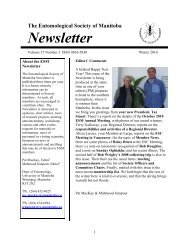Evidence of uranium biomineralization in sandstone-hosted roll-front ...
Evidence of uranium biomineralization in sandstone-hosted roll-front ...
Evidence of uranium biomineralization in sandstone-hosted roll-front ...
You also want an ePaper? Increase the reach of your titles
YUMPU automatically turns print PDFs into web optimized ePapers that Google loves.
Ore Geology Reviews 26 (2005) 198–206<br />
www.elsevier.com/locate/oregeorev<br />
<strong>Evidence</strong> <strong>of</strong> <strong>uranium</strong> <strong>biom<strong>in</strong>eralization</strong> <strong>in</strong> <strong>sandstone</strong>-<strong>hosted</strong><br />
<strong>roll</strong>-<strong>front</strong> <strong>uranium</strong> deposits, northwestern Ch<strong>in</strong>a<br />
Maozhong M<strong>in</strong> a,b, *, Huifang Xu c , Jia Chen a , Mostafa Fayek d<br />
a Department <strong>of</strong> Earth Sciences, State Key Laboratory <strong>of</strong> M<strong>in</strong>eral Deposit Research, Nanj<strong>in</strong>g University, Nanj<strong>in</strong>g 210093,<br />
People’s Republic <strong>of</strong> Ch<strong>in</strong>a<br />
b State Key Laboratory <strong>of</strong> Solid State Microstructures, Nanj<strong>in</strong>g University, Nanj<strong>in</strong>g 210093, People’s Republic <strong>of</strong> Ch<strong>in</strong>a<br />
c Department <strong>of</strong> Earth and Planetary Sciences, University <strong>of</strong> New Mexico, Albuquerque NM87131-1116, United States <strong>of</strong> America<br />
d Department <strong>of</strong> Earth and Planetary Sciences, University <strong>of</strong> Tennessee/ORNL, TN 37996, United States <strong>of</strong> America<br />
Received 22 September 2003; accepted 15 October 2004<br />
Available onl<strong>in</strong>e 25 January 2005<br />
Abstract<br />
We show evidence that the primary <strong>uranium</strong> m<strong>in</strong>erals, uran<strong>in</strong>ite and c<strong>of</strong>f<strong>in</strong>ite, from high-grade ore samples (U 3 O 8 N0.3%) <strong>in</strong><br />
the Wuyiyi, Wuyier, and Wuyisan <strong>sandstone</strong>-<strong>hosted</strong> <strong>roll</strong>-<strong>front</strong> <strong>uranium</strong> deposits, X<strong>in</strong>jiang, northwestern Ch<strong>in</strong>a were<br />
biogenically precipitated and psuedomorphically replace fungi and bacteria. Uranium (VI), which was the sole electron<br />
acceptor, was likely to have been enzymically reduced. Post-mortem accumulation <strong>of</strong> <strong>uranium</strong> may have also occurred through<br />
physio-chemical <strong>in</strong>teraction between <strong>uranium</strong> and negatively-charged cellular sites, and <strong>in</strong>organic adsorption or precipitation<br />
reactions. These results suggest that microorganisms may have played a key role <strong>in</strong> formation <strong>of</strong> the <strong>sandstone</strong>- or <strong>roll</strong>-type<br />
<strong>uranium</strong> deposits, which are among the most economically significant <strong>uranium</strong> deposits <strong>in</strong> the world.<br />
D 2004 Elsevier B.V. All rights reserved.<br />
Keywords: Roll-<strong>front</strong> <strong>uranium</strong> deposit; Sandstone; Biom<strong>in</strong>eralization; Ch<strong>in</strong>a<br />
1. Introduction<br />
* Correspond<strong>in</strong>g author. Department <strong>of</strong> Earth Sciences, State Key<br />
Laboratory <strong>of</strong> M<strong>in</strong>eral Deposit Research, Nanj<strong>in</strong>g University,<br />
Nanj<strong>in</strong>g 210093, People’s Republic <strong>of</strong> Ch<strong>in</strong>a.<br />
E-mail address: mzm<strong>in</strong>@nju.edu.cn (M. M<strong>in</strong>).<br />
Reduction <strong>of</strong> U(VI) by microorganisms lead<strong>in</strong>g to<br />
U(IV) m<strong>in</strong>eral precipitation has been extensively<br />
studied experimentally, us<strong>in</strong>g dilute U-bear<strong>in</strong>g solutions<br />
(Lovley et al., 1991, 1996; Phillips et al.,<br />
1995; Barton et al., 1996; Tucker et al., 1998;<br />
Abdelouias et al., 1999; Panak, 2000; Haveman and<br />
Pedersen, 2002; Russell et al., 2003). Some <strong>of</strong> the<br />
first microorganisms found to reduce U(VI) were<br />
dissimilatory bacteria, such as Geobacter metallireducens<br />
and Shewanella putrefaciens, which are Fereduc<strong>in</strong>g<br />
species. These microorganisms can use<br />
U(VI) as an electron acceptor, <strong>in</strong>stead <strong>of</strong> Fe(III)<br />
(Lovley et al., 1991). Several experiments have<br />
shown that reduction <strong>of</strong> U(VI) is an enzymatically<br />
0169-1368/$ - see <strong>front</strong> matter D 2004 Elsevier B.V. All rights reserved.<br />
doi:10.1016/j.oregeorev.2004.10.003
M. M<strong>in</strong> et al. / Ore Geology Reviews 26 (2005) 198–206 199<br />
mediated reaction (Lovley and Phillips, 1992; Lovley<br />
et al., 1993). These experiments also showed that<br />
HS , used <strong>in</strong> these experiments to establish reduc<strong>in</strong>g<br />
conditions, reacts slowly with U(VI) compared with<br />
the biocatalyzed reaction, at near neutral pH and near<br />
room temperature.<br />
Despite the above, there has been little direct<br />
evidence <strong>of</strong> biogenically precipitated U-m<strong>in</strong>erals<br />
associated with <strong>uranium</strong> deposits (Milodowski et al.,<br />
1990). The objective <strong>of</strong> the present paper is to show<br />
that primary uran<strong>in</strong>ite and c<strong>of</strong>f<strong>in</strong>ite from high-grade<br />
ore samples (U 3 O 8 N0.3%) from the Wuyiyi, Wuyier,<br />
and Wuyisan <strong>sandstone</strong>-<strong>hosted</strong> <strong>roll</strong>-<strong>front</strong> U-deposits,<br />
X<strong>in</strong>jiang, NW Ch<strong>in</strong>a, which psuedomorphically<br />
replace fungi and bacteria, are <strong>of</strong> biogenic orig<strong>in</strong><br />
(Lowenstam, 1981).<br />
2. Geologic sett<strong>in</strong>g<br />
The Wuyiyi, Wuyier, and Wuyisan, <strong>roll</strong>-<strong>front</strong><br />
<strong>uranium</strong> deposits are located along the southwest<br />
border <strong>of</strong> the YL bas<strong>in</strong>, X<strong>in</strong>jiang, NW Ch<strong>in</strong>a. A<br />
detailed geological sett<strong>in</strong>g for these deposits has<br />
been previously given by M<strong>in</strong> et al. (2001, 2005).<br />
The YL Bas<strong>in</strong> covers an area <strong>of</strong> approximately<br />
16,000 km 2 (Fig. 1a) and is a closed cont<strong>in</strong>ental<br />
bas<strong>in</strong> that has an approximately NW–SE trend.<br />
Basement rocks <strong>of</strong> the YL Bas<strong>in</strong> consist <strong>of</strong><br />
Proterozoic metasediments, Carboniferous <strong>in</strong>termediate-acidic<br />
volcanic and volcaniclastic rocks, and<br />
Hercynian age granites. Cap rocks <strong>of</strong> the bas<strong>in</strong><br />
comprise Triassic, Jurassic, Cretaceous, and Tertiary<br />
conglomerates, <strong>sandstone</strong>s and pelites, Jurassic coal,<br />
and Quaternary gravel, sand and clay. The oldest<br />
rocks exposed <strong>in</strong> the Wuyiyi, Wuyier, and Wuyisan<br />
ore districts are metamorphosed quartzite, marble,<br />
carbonaceous slate <strong>of</strong> the Middle Proterozoic, which<br />
are unconformably overla<strong>in</strong> by Lower Palaeozoic<br />
conglomerates, <strong>sandstone</strong>s, pelites and limestones.<br />
The Carboniferous <strong>in</strong>termediate-acidic volcanic<br />
rocks rest unconformably on conglomerates, <strong>sandstone</strong>s,<br />
pelites and limestones <strong>of</strong> the Lower Palaeozoic,<br />
which are, <strong>in</strong> turn, unconformably overla<strong>in</strong> by<br />
<strong>sandstone</strong>s and pelites <strong>of</strong> the Upper Triassic<br />
Xiaoquangou Group. The latter are conformably<br />
overla<strong>in</strong> by conglomerates, <strong>sandstone</strong>s, pelites and<br />
coal <strong>of</strong> the Lower–Middle Jurassic Shuixigou<br />
Group. The Upper Cretaceous red conglomerates<br />
and <strong>sandstone</strong>s lie conformably on top <strong>of</strong> the<br />
Lower–Middle Jurassic Shuixigou Group, which<br />
are conformably overla<strong>in</strong> by the Tertiary red<br />
conglomerates, <strong>sandstone</strong>s and pelites, which are<br />
unconformably overla<strong>in</strong> by Quaternary gravel, sand<br />
and clay.<br />
The three deposits <strong>in</strong> question occur <strong>in</strong> the lower to<br />
middle units <strong>of</strong> the cont<strong>in</strong>ental Jurassic Shuixigou<br />
Group. Ore-bear<strong>in</strong>g rocks <strong>of</strong> the Jurassic Shuixigou<br />
Group dip to the northeast. The thickness <strong>of</strong> the<br />
Shuixigou Group ranges from 220 to 440 m and can<br />
be divided <strong>in</strong>to three members. These are, from<br />
bottom to top, the Badaowan Formation, which lies<br />
unconformably over the Xiaoquangou Group (Middle–Upper<br />
Triassic), the Sangonghe Formation, which<br />
lies conformably on top <strong>of</strong> the Badaowan Formation,<br />
and the Xishanyao Formation, which lies conformably<br />
on top <strong>of</strong> the Sangonghe Formation. Uranium<br />
m<strong>in</strong>eralization occurs with<strong>in</strong> five dist<strong>in</strong>ct stratigraphic<br />
horizons, all <strong>of</strong> which follow the <strong>in</strong>ner marg<strong>in</strong> <strong>of</strong> the<br />
bas<strong>in</strong>.<br />
The <strong>uranium</strong> orebodies consist <strong>of</strong> medium- to<br />
coarse-gra<strong>in</strong>ed <strong>sandstone</strong> and occur at the location<br />
<strong>of</strong> an abrupt change <strong>in</strong> redox conditions. On the updip<br />
side <strong>of</strong> the <strong>roll</strong>-<strong>front</strong> and tabular-shaped ore<br />
bodies, the host <strong>sandstone</strong> is highly oxidized,<br />
yellowish orange to red <strong>in</strong> color, lacks pyrite, and<br />
has little carbonaceous debris. These oxidized<br />
tongues <strong>of</strong> <strong>sandstone</strong> can extend for tens <strong>of</strong><br />
kilometers. Ore samples are gray, dark gray or<br />
black <strong>in</strong> color. Uranium-rich rocks are <strong>of</strong>ten<br />
enriched <strong>in</strong> molybdenum and vanadium, and are<br />
commonly <strong>in</strong> sharp contact with barren altered<br />
rocks. Pr<strong>in</strong>cipal epigenetic metallic m<strong>in</strong>erals <strong>in</strong> the<br />
ores, from oldest to youngest, are hematite, sphalerite,<br />
pyrite, marcasite, uran<strong>in</strong>ite and c<strong>of</strong>f<strong>in</strong>ite. There<br />
is abundance <strong>of</strong> fossilized wood fragments associated<br />
with the ore bodies. Some <strong>of</strong> wood fragments<br />
were m<strong>in</strong>eralized, where uran<strong>in</strong>ite and c<strong>of</strong>f<strong>in</strong>ite<br />
preserve the orig<strong>in</strong>al wood-cell texture (M<strong>in</strong> et al.,<br />
2001). The U-m<strong>in</strong>eralization gives young wholerock<br />
U–Pb isotope ages, rang<strong>in</strong>g from 11.7F0.3 Ma<br />
to 15.8F0.4 Ma (M<strong>in</strong> et al., 2001). The tim<strong>in</strong>g <strong>of</strong><br />
<strong>uranium</strong> m<strong>in</strong>eralization for the deposits therefore<br />
corresponds with the Himalayan (Late Tertiary)<br />
tectonism that affected the northwest region <strong>of</strong><br />
Ch<strong>in</strong>a.
200<br />
M. M<strong>in</strong> et al. / Ore Geology Reviews 26 (2005) 198–206<br />
Fig. 1. Regional geological sett<strong>in</strong>g (a) and North–South geological cross-sections (b) <strong>of</strong> the Wuyiyi, Wuyier, and Wuyisan <strong>uranium</strong> districts <strong>in</strong><br />
the YL Bas<strong>in</strong> (modified after 216 Geological Party, 1997).<br />
The deposits are genetically similar to <strong>sandstone</strong><strong>hosted</strong><br />
<strong>roll</strong>-<strong>front</strong> U-deposits found <strong>in</strong> the Colorado<br />
plateau, southern Texas, the Tertiary Bas<strong>in</strong> <strong>of</strong> Wyom<strong>in</strong>g<br />
and the Ambrosia Lake <strong>of</strong> New Mexico, USA<br />
(Granger et al., 1961; Dahl and Hagmaier, 1974;<br />
Reynolds and Goldhaber, 1982), the East Kalkarod,<br />
Goulds Dam, Honeymoon and Many<strong>in</strong>gee districts,<br />
Australia (IAEA, 1996), Irkol, Kanzhugan, Kyztu,<br />
Mynkuduk and Uvanas <strong>in</strong> Kazakhstan, Folakara,<br />
Madagascar, La Sierrita, Mexico, and the Agron,<br />
Aktau, Bukeenai and Uchkuduk districts <strong>of</strong> Uzbekistan<br />
(IAEA, 1996).
M. M<strong>in</strong> et al. / Ore Geology Reviews 26 (2005) 198–206 201<br />
3. Methodology<br />
Ore samples were selected from drillholes that<br />
<strong>in</strong>tersect uraniferous orebodies <strong>in</strong> the Wuyiyi, Wuyier,<br />
and Wuyisan deposits. Polished th<strong>in</strong> sections were<br />
exam<strong>in</strong>ed us<strong>in</strong>g optical microscopy, electron microprobe,<br />
scann<strong>in</strong>g electron microscopy and scann<strong>in</strong>g<br />
transmission electron microscopy (STEM) to determ<strong>in</strong>e<br />
m<strong>in</strong>eral paragenesis and textures. SEM analyses<br />
<strong>of</strong> <strong>uranium</strong> m<strong>in</strong>erals and fossilized microorganisms<br />
were made us<strong>in</strong>g a JEOL JSM-5800LV <strong>in</strong>strument at<br />
the Department <strong>of</strong> Earth and Planetary Sciences,<br />
University <strong>of</strong> New Mexico, USA. Chemical compositions<br />
<strong>of</strong> fossilized microorganism were determ<strong>in</strong>ed<br />
with an X-ray EDS analyzer on the SEM. TEM<br />
analyses and electron diffraction studies were carried<br />
out us<strong>in</strong>g JEOL JEM-2010 HRTEM and Phillips 420<br />
FEG XRD <strong>in</strong>struments, respectively, both located at<br />
the Department <strong>of</strong> Earth and Planetary Sciences,<br />
University <strong>of</strong> New Mexico, USA.<br />
4. Results<br />
SEM analyses <strong>in</strong>dicate that the primary U-m<strong>in</strong>erals,<br />
uran<strong>in</strong>ite (UO 2 ) and c<strong>of</strong>f<strong>in</strong>ite (USiO 4 ), have<br />
pseudomorphs after microbe <strong>in</strong> the ore samples<br />
(Figs. 2 and 3). Uran<strong>in</strong>ite with<strong>in</strong> the fossilized wood<br />
pseudomorphically replaces branch<strong>in</strong>g dendritic<br />
hyphae and globular fungi spores (Figs. 2a–d).<br />
Individual hyphae have a tubular structure (Fig. 2d).<br />
The size <strong>of</strong> the uran<strong>in</strong>ite-m<strong>in</strong>eralized hyphae and<br />
spores ranges from 0.2 to 0.5 Am and from 0.5 to 1.2<br />
Am across, respectively. EDS analysis shows that the<br />
hyphae and spores have a simple chemical composition<br />
(uran<strong>in</strong>ite, UO 2 ; Fig. 2b).<br />
The c<strong>of</strong>f<strong>in</strong>ite-m<strong>in</strong>eralized worm-like bacteria have<br />
a length <strong>of</strong> 1.7 to 2.2 Am, and an average width <strong>of</strong> 0.3<br />
Am (Fig. 3a). EDS analyses <strong>in</strong>dicate that the wormlike<br />
bacteria conta<strong>in</strong> U and Si (c<strong>of</strong>f<strong>in</strong>ite, USiO 4 ; Fig.<br />
3b). Almost all uran<strong>in</strong>ite <strong>in</strong> the ores surround<strong>in</strong>g the<br />
fossilized wood has a structure resembl<strong>in</strong>g globular<br />
cocci with diameters <strong>of</strong> 2 to 3 Am and occurs as<br />
botryoidal aggregate on surfaces <strong>of</strong> the organic debris<br />
(Fig. 3c).<br />
Structures resembl<strong>in</strong>g nano-scale organisms<br />
replaced by UO 2 (uran<strong>in</strong>ite) were detected us<strong>in</strong>g<br />
HRTEM imag<strong>in</strong>g (Fig. 3d). Although identification<br />
<strong>of</strong> these organisms is beyond the scope <strong>of</strong> this study,<br />
these organisms are 20 to 25 nm <strong>in</strong> length and have an<br />
average width <strong>of</strong> 8 nm. Electron diffraction patterns <strong>of</strong><br />
selected area (lower left <strong>in</strong>serted <strong>in</strong> Fig. 3d) show a<br />
large number <strong>of</strong> uran<strong>in</strong>ite nano-crystals, which are<br />
arranged <strong>in</strong> ordered three-dimensional arrays.<br />
Framboidal pyrite commonly occurs with<strong>in</strong> the<br />
matrix <strong>of</strong> the <strong>uranium</strong> m<strong>in</strong>erals and with<strong>in</strong> the<br />
fossilized wood cells (Fig. 3e), and is an early<br />
diagenetic m<strong>in</strong>eral. It is a spherical to sub-spherical<br />
aggregates <strong>of</strong> equigranular microcrystals. The average<br />
diameter <strong>of</strong> the spherical framboid is between 10 and<br />
12 Am. With<strong>in</strong> <strong>in</strong>dividual framboids, microcrystals are<br />
remarkably uniform <strong>in</strong> size (10 Am across) and shape<br />
and are <strong>of</strong>ten arranged <strong>in</strong> ordered three-dimensional<br />
arrays (Fig. 3e). SEM <strong>in</strong>vestigations <strong>in</strong>dicate that ratio<br />
<strong>of</strong> the framboid diameter to microcrystal diameter is<br />
generally between 20 and 25. The pack<strong>in</strong>g arrangement<br />
<strong>of</strong> the microcrystals is typically dense, approach<strong>in</strong>g<br />
cubic closest pack<strong>in</strong>g. The framboidal pyrite is<br />
commonly replaced by <strong>uranium</strong> (Fig. 3f). It is<br />
<strong>in</strong>dicated that U can partially be reduced by sulfur<br />
<strong>in</strong> pyrite that is earlier than uran<strong>in</strong>ite. Electron<br />
diffraction patterns <strong>of</strong> the framboidal pyrite (Fig. 3e)<br />
show that there is abundant uran<strong>in</strong>ite present.<br />
5. Discussion and conclusions<br />
The <strong>uranium</strong> cycle near the Earth’s surface is<br />
ma<strong>in</strong>ly cont<strong>roll</strong>ed by redox reactions. Sandstone<strong>hosted</strong><br />
or <strong>roll</strong>-<strong>front</strong> U-deposits are the most abundant<br />
<strong>uranium</strong> reservoirs <strong>in</strong> the world (Degens and Ittekkot,<br />
1982; Langmuir, 1978; Suzuki and Banfield, 1999),<br />
and are also economically the most important U-<br />
resources <strong>in</strong> Ch<strong>in</strong>a. Precipitation mechanisms for<br />
U(VI) <strong>in</strong> <strong>roll</strong>-<strong>front</strong> U-deposits are controversial. The<br />
conventional view is that U(VI) reduction is due to an<br />
<strong>in</strong>organic reaction <strong>in</strong> which sulphide, molecular<br />
hydrogen or organic compounds function as the<br />
reductants (e.g., Nash et al., 1981; Langmuir, 1978;<br />
Charles, 1996; Suzuki and Banfield, 1999).<br />
Preservation <strong>of</strong> micr<strong>of</strong>ossils <strong>in</strong> the Wuyiyi, Wuyier,<br />
and Wuyisan <strong>uranium</strong> deposits was likely due to<br />
b<strong>in</strong>d<strong>in</strong>g between U and microbial cells (e.g., Gravesen<br />
et al., 1994). Sandstone-<strong>hosted</strong> U-deposits conta<strong>in</strong><br />
abundant organic material (C org =0.1 to 2.1 wt.%), and<br />
formed by reduction <strong>of</strong> U(VI) to <strong>in</strong>soluble U(IV) at
202<br />
M. M<strong>in</strong> et al. / Ore Geology Reviews 26 (2005) 198–206<br />
5µm<br />
5µm<br />
U<br />
cps<br />
Au<br />
b<br />
U<br />
10<br />
U<br />
5<br />
a<br />
0<br />
O<br />
Si U<br />
U<br />
U<br />
0 2 4 6 8<br />
Energy (keV)<br />
5µm 10µm<br />
5µm<br />
10µm<br />
U<br />
U<br />
c<br />
d<br />
Fig. 2. (a) SEM micrograph show<strong>in</strong>g morphology <strong>of</strong> branch<strong>in</strong>g dendritic hyphae (white, U) and globular spores (white, U) <strong>of</strong> fungi, which were<br />
entirely replaced by UO 2 (uran<strong>in</strong>ite) with<strong>in</strong> fossilized wood cell-holes <strong>of</strong> the ore from the Wuyisan deposit. Insert (lower left corner) is modern<br />
fungi (Gravesen et al., 1994). (b) EDS-spectrum from the hyphae and spores <strong>in</strong> (a), (c), (d). Au peaks result from the Au grid. (c) SEM<br />
micrograph show<strong>in</strong>g morphology <strong>of</strong> globular spores (white, U) and (gray white, U) fungi, which were entirely replaced by UO 2 (uran<strong>in</strong>ite), as<br />
shown <strong>in</strong> (b), and with<strong>in</strong> fossilized wood cell-holes <strong>of</strong> the ore from the Wuyisan deposit. (d) SEM micrograph show<strong>in</strong>g morphology <strong>of</strong><br />
aggregated tubular hyphae (gray white, U) and globular spores (white, U), entirely replaced by UO 2 (uran<strong>in</strong>ite), as shown <strong>in</strong> Fig. (b). Sample is<br />
from the Wuyiyi deposit.<br />
relatively low-temperatures <strong>of</strong> 40 to 50 8C (Suzuki<br />
and Banfield, 1999; M<strong>in</strong> et al., 2003). Low-temperature,<br />
organic rich environments <strong>in</strong> <strong>sandstone</strong>s have<br />
been shown, experimentally, to be suitable for<br />
grow<strong>in</strong>g various microorganisms that can enzymatically<br />
reduce U(VI) to U(IV) (Lovley and Phillips,<br />
1992). In particular, the fossilized wood cells <strong>in</strong> the<br />
host <strong>sandstone</strong> are ideal environments for growth <strong>of</strong><br />
microorganisms because the wood supplies both a<br />
source <strong>of</strong> nourishment and space necessary for<br />
growth.<br />
The results <strong>of</strong> this study strongly suggest that U-<br />
reduction <strong>in</strong> the Wuyiyi, Wuyier, and Wuyisan <strong>roll</strong><strong>front</strong><br />
deposits was due to U-metal–organic material<br />
<strong>in</strong>teraction and microbially-mediated reactions. Both<br />
bacteria and fungi were likely responsible for U-<br />
reduction. Dur<strong>in</strong>g the <strong>in</strong>itial stage <strong>of</strong> m<strong>in</strong>eralization,<br />
liv<strong>in</strong>g bacteria enzymatically reduced and accumulated<br />
U(VI) <strong>in</strong> the host <strong>sandstone</strong>s, and grew us<strong>in</strong>g<br />
U(VI) as the sole electron acceptor (Lovley et al.,<br />
1991). This metabolism-dependent U accumulation<br />
consists <strong>of</strong> extracellular (outer membrane) precipita-
M. M<strong>in</strong> et al. / Ore Geology Reviews 26 (2005) 198–206 203<br />
5µm<br />
5µm<br />
cps<br />
20<br />
b<br />
U<br />
15<br />
10<br />
Si<br />
U<br />
a<br />
5<br />
0<br />
9.00 nm<br />
O<br />
U<br />
U<br />
U<br />
0 2 4 6 8<br />
Energy (keV)<br />
c<br />
d<br />
Py<br />
e<br />
f<br />
Fig. 3. (a) SEM micrograph show<strong>in</strong>g the morphology <strong>of</strong> worm-like bacteria (Desulfovibrio desulfuricans?), completely replaced by<br />
USiO 4 (c<strong>of</strong>f<strong>in</strong>ite) <strong>in</strong> a fossilized wood cell <strong>of</strong> the <strong>sandstone</strong>-<strong>hosted</strong> <strong>uranium</strong> ore from the Wuyiyi deposit. (b) EDS spectrum from the worm-like<br />
bacteria <strong>in</strong> (a). Au peaks result from the Au grid. (c) SEM micrograph show<strong>in</strong>g morphology <strong>of</strong> globular cocci, entirely replaced by UO 2<br />
(uran<strong>in</strong>ite), and <strong>of</strong> botryoidal structure on surface <strong>of</strong> m<strong>in</strong>eral clastics <strong>in</strong> the ore from the Wuyier deposit. (d) HRTEM micrograph show<strong>in</strong>g<br />
morphology <strong>of</strong> a structure resembl<strong>in</strong>g nano-organism replaced by UO 2 (uran<strong>in</strong>ite nano-crystals, black). Inserted small pattern (lower left) is<br />
from the uran<strong>in</strong>ite nano-crystals. Sample is from the Wuyiyi deposit. (e) SEM micrograph show<strong>in</strong>g morphology <strong>of</strong> framboidal pyrite (Py) <strong>in</strong> the<br />
fossilized wood cell. (f) X-ray emission image <strong>of</strong> the same view as <strong>in</strong> (e), for element U.
204<br />
M. M<strong>in</strong> et al. / Ore Geology Reviews 26 (2005) 198–206<br />
tion with metabolically-produced ligands, complexation<br />
aris<strong>in</strong>g from excreted metabolites, and precipitation<br />
due to enzyme-mediated changes <strong>in</strong> the redox<br />
state (Gadd, 1996; Suzuki and Banfield, 1999).<br />
Uranium uptake by fungi was attributed to complexation<br />
with nitrogen at chit<strong>in</strong> am<strong>in</strong>e b<strong>in</strong>d<strong>in</strong>g sites <strong>in</strong> the<br />
cell wall, subsequently adsorbed with<strong>in</strong> the chit<strong>in</strong><br />
matrix, and deposition <strong>of</strong> uranyl hydroxide (Tsezos<br />
and Volesky, 1982). When amounts <strong>of</strong> accumulated<br />
U(VI) <strong>in</strong>creased on the cell walls, the microorganisms<br />
eventually died due to U toxicity and high radiation<br />
doses.<br />
However, U accumulation did not stop once the<br />
cells died. Replacement <strong>of</strong> fungi and bacteria by<br />
<strong>uranium</strong> m<strong>in</strong>erals suggest that post-mortem accumulation<br />
<strong>of</strong> U was likely most important <strong>in</strong> the formation<br />
<strong>of</strong> the biogenic uran<strong>in</strong>ite and c<strong>of</strong>f<strong>in</strong>ite <strong>in</strong> the <strong>roll</strong>-<strong>front</strong><br />
deposits under discussion. Post-mortem accumulation<br />
<strong>of</strong> U usually occurs between <strong>uranium</strong> species and<br />
negatively charged sites <strong>in</strong> the non-liv<strong>in</strong>g microorganisms<br />
(Suzuki and Banfield, 1999), or by<br />
<strong>in</strong>organic adsorption and precipitation reactions,<br />
where the microorganism is eventually replaced by<br />
the U-bear<strong>in</strong>g phase. The framboidal pyrite commonly<br />
occurs <strong>in</strong> the matrix <strong>of</strong> the U ores, with<strong>in</strong> the<br />
fossilized wood cells (Fig. 3e), and along cleavages<br />
<strong>of</strong> the clastic m<strong>in</strong>erals, such as biotite and feldspar.<br />
The framboidal texture and close association with<br />
carbonized, fossilized plant fragments implies an <strong>in</strong><br />
situ biogenic orig<strong>in</strong> due to bacterial sulfate reduction<br />
(Northrop and Goldhaber, 1990). Recent studies<br />
support this observation because they show that<br />
control over pyrite morphology is related to the<br />
amount and reactivity <strong>of</strong> the organic matter with<strong>in</strong><br />
the deposited sediments (Abdelouias et al., 1999).<br />
Butler and Rickard (2000) and Taylor and Macquaker<br />
(2000) show that framboidal pyrite precipitates from<br />
Fe-dom<strong>in</strong>ated fluids <strong>in</strong> the region <strong>of</strong> organic matter as<br />
a result <strong>of</strong> bacterial sulfate reduction where, locally,<br />
sulfide production rates are high enough for the fluids<br />
to reach strong supersaturation with respect to FeS.<br />
Euhedral (non-framboidal) pyrite forms from irondom<strong>in</strong>ated<br />
fluids <strong>in</strong> which sulfide production rate is<br />
such that FeS saturation is not reached. Additionally,<br />
detailed exam<strong>in</strong>ation <strong>of</strong> the framboid-like pyrite<br />
reveals that a strong correlation between pyrite<br />
morphologies and the presence <strong>of</strong> (or amount <strong>of</strong><br />
<strong>in</strong>troduced) S 0 exists. In the presence <strong>of</strong> excess S 0 ,<br />
pyrite morphologies changed from euhedral and<br />
framboid-like to spheroidal or acicular aggregates.<br />
The observations made <strong>in</strong> this study suggest that<br />
microorganisms have played a key role <strong>in</strong> formation<br />
<strong>of</strong> <strong>roll</strong>-<strong>front</strong> Wuyiyi, Wuyier, and Wuyisan U-deposits,<br />
Ch<strong>in</strong>a. In addition to U, Mo, Se and Rh are also<br />
associated with these deposits as by-products, and<br />
spatially have a zoned distribution <strong>in</strong> the C-shaped<br />
<strong>roll</strong>-<strong>front</strong> ore bodies (Jensen, 1958; Reynolds and<br />
Goldhaber, 1982; Northrop and Goldhaber, 1990).<br />
This spatial distribution <strong>of</strong> U, Mo, Se and Re <strong>in</strong> the<br />
<strong>sandstone</strong>-<strong>hosted</strong> <strong>roll</strong>-<strong>front</strong> U ores may be due to<br />
spatially distributed anaerobic microorganisms that<br />
can selectively enzymatically U, Mo, Se and Re<br />
(Tucker et al., 1998; Xu et al., 2000).<br />
The potential for U contam<strong>in</strong>ation <strong>of</strong> surface- and<br />
groundwaters through m<strong>in</strong><strong>in</strong>g and mill<strong>in</strong>g operations,<br />
spent fuel reprocess<strong>in</strong>g, disposal <strong>of</strong> nuclear wastes<br />
and nuclear explosion is an environmental concern.<br />
The results presented here suggest that large-scale<br />
microbial remediation <strong>of</strong> U is possible. Other radioactive<br />
metals, such as Pu and Tc <strong>in</strong> high-level<br />
radioactive waste, have multiple redox states, similar<br />
chemical behaviors to U, and are <strong>in</strong>soluble <strong>in</strong> the<br />
reduced form. Therefore, these radionuclides can<br />
also be microbially sequestered. Uptake and precipitation<br />
<strong>of</strong> U and other radionuclides by microorganisms<br />
may be a cost-effective method <strong>of</strong><br />
radionuclide remediation. However, to effectively<br />
use microorganisms to remediate heavy metal and<br />
radionuclide contam<strong>in</strong>ated subsurface environments,<br />
more work is required to isolate and culture those<br />
microorganisms associated with highly radioactive<br />
environments, such as U-deposits and associated<br />
m<strong>in</strong><strong>in</strong>g and mill<strong>in</strong>g operations, because these microorganisms<br />
are likely able to reduce and accumulate<br />
far larger quantities <strong>of</strong> U over a wider range <strong>of</strong> pH<br />
conditions than microorganisms from uncontam<strong>in</strong>ated<br />
sites (Wade and DiChrist<strong>in</strong>a, 2001).<br />
Acknowledgements<br />
We thank scientists at Department <strong>of</strong> Earth and<br />
Planetary Sciences, University <strong>of</strong> New Mexico (USA)<br />
for their technical support. This work was supported<br />
by the National Natural Science Foundation <strong>of</strong> Ch<strong>in</strong>a<br />
(NNSFC, Grant No. 40173031), the International
M. M<strong>in</strong> et al. / Ore Geology Reviews 26 (2005) 198–206 205<br />
Cooperative Research Foundation <strong>of</strong> NNSFC (Grant<br />
No.2002-40210104086) and Ph.D. Base Foundation<br />
<strong>of</strong> Ch<strong>in</strong>ese Education M<strong>in</strong>istry (Grant no.<br />
20020284036). The manuscript benefited considerably<br />
from critical reviews and helpful comments by<br />
Nigel Cook and two anonymous reviewers.<br />
References<br />
216 Geological Party, 1997. Geological report <strong>of</strong> the Wuyiyi<br />
<strong>uranium</strong> deposit. Unpublished geological report (<strong>in</strong> Ch<strong>in</strong>ese),<br />
p. 6–10.<br />
Abdelouias, A., Lutze, W., Nuttall, H.E., 1999. Oxidative dissolution<br />
<strong>of</strong> uran<strong>in</strong>ite precipitated on Navajo <strong>sandstone</strong>. Journal<br />
<strong>of</strong> Contam<strong>in</strong>ant Hydrology 36, 353–375.<br />
Barton, L.L., Choudhury, K., Thomson, B.M., Steenhoudt, K.,<br />
Gr<strong>of</strong>fman, A.R., 1996. Bacterial reduction <strong>of</strong> soluble <strong>uranium</strong>:<br />
the first step <strong>of</strong> <strong>in</strong> situ immobilization <strong>of</strong> <strong>uranium</strong>. Radioactive<br />
Waste Management and Environmental Restoration 20,<br />
141–145.<br />
Butler, I.B., Rickard, D., 2000. Framboidal pyrite formation via the<br />
oxidation <strong>of</strong> iron (II) monosulfide by hydrogen sulphide.<br />
Geochimica et Cosmochimica Acta 64, 2665–2672.<br />
Charles, S., 1996. The roles <strong>of</strong> organic matter <strong>in</strong> the formation <strong>of</strong><br />
<strong>uranium</strong> deposits <strong>in</strong> sedimentary rocks. Ore Geology Reviews<br />
11, 53–59.<br />
Dahl, A.R., Hagmaier, J.L., 1974. Genesis and characteristics <strong>of</strong> the<br />
southern Power River bas<strong>in</strong> <strong>uranium</strong> deposits, Wyom<strong>in</strong>g, USA.<br />
Formation <strong>of</strong> Uranium Ore Deposits. International Atomic<br />
Energy Agency, Vienna, pp. 201–216.<br />
Degens, E.T., Ittekkot, V., 1982. In situ metal-sta<strong>in</strong><strong>in</strong>g <strong>of</strong> biological<br />
membranes <strong>in</strong> sediments. Nature 298, 262–264.<br />
Gadd, G.M., 1996. Influence <strong>of</strong> microorganisms on the environmental<br />
fate <strong>of</strong> radionuclides. Endeavour 20, 150–156.<br />
Granger, H.C., Santos, E.S., Dean, B.G., Moore, F.B., 1961.<br />
Sandstone-type <strong>uranium</strong> deposits at Ambrosia Lake, New<br />
Mexico—an <strong>in</strong>terim report. Economic Geology 56, 1179–1209.<br />
Gravesen, S., Frisvad, J.C., Samson, R.A., 1994. Fungi. Special-<br />
Trykkeriet Viborg, Denmark. 156 pp.<br />
Haveman, S.A., Pedersen, K., 2002. Microbially mediated redox<br />
processes <strong>in</strong> natural analogues for radioactive waste. Journal <strong>of</strong><br />
Contam<strong>in</strong>ant Hydrology 55, 161–174.<br />
IAEA, 1996. Guidebook to Accompany IAEA Map: World<br />
Distribution <strong>of</strong> Uranium Deposits. Vienna, p. 20–210.<br />
Jensen, M.L., 1958. Sulfur isotopes and the orig<strong>in</strong> <strong>of</strong> <strong>sandstone</strong>-type<br />
<strong>uranium</strong> deposit. Economic Geology 53, 598–616.<br />
Langmuir, D., 1978. Uranium solution–m<strong>in</strong>eral equilibria at low<br />
temperatures with applications to sedimentary ore deposits.<br />
Geochimica et Cosmochimica Acta 42, 547–569.<br />
Lovley, D.R., Phillips, E.J.P., 1992. Reduction <strong>of</strong> <strong>uranium</strong> by<br />
Desulfovibrio desulfuricans. Applied and Environmental Microbiology<br />
58, 850–856.<br />
Lovley, D.R., Phillips, E.J.P., Gorby, Y.A., Landa, E.R., 1991.<br />
Microbial reduction <strong>of</strong> <strong>uranium</strong>. Nature 350, 413–416.<br />
Lovley, D.R., Roden, E.E., Phillips, E.J.P., Woodward, J.C., 1993.<br />
Enzymatic iron and <strong>uranium</strong> reduction by sulfate-reduc<strong>in</strong>g<br />
bacteria. Mar<strong>in</strong>e Geology 113, 41–53.<br />
Lovley, D.R., Coates, J.D., Blunt-Harris, E.L., Phillips, E.J.P.,<br />
Woodward, J.C., 1996. Humic substances as electron acceptors<br />
for microbial respiration. Nature 382, 445–448.<br />
Lowenstam, N.A., 1981. M<strong>in</strong>erals formed by organisms. Science<br />
211, 1126–1130.<br />
Milodowski, A.E., West, J.M., Pearce, J.M., Hyslop, E.K., Basham,<br />
I.R., Hooker, P.J., 1990. Uranium-m<strong>in</strong>eralized microorganisms<br />
associated with uraniferous hydrocarbons <strong>in</strong> southwest Scotland.<br />
Nature 347, 465–467.<br />
M<strong>in</strong>, M.Z., Luo, X.Z., Mao, S.L., Wang, Z.Q., Wang, R.C., Q<strong>in</strong>,<br />
L.F., Tan, X.L., 2001. An excellent fossilized wood cell<br />
texture with primary <strong>uranium</strong> m<strong>in</strong>erals at a <strong>sandstone</strong>-<strong>hosted</strong><br />
<strong>roll</strong>-type <strong>uranium</strong> deposit, NW Ch<strong>in</strong>a. Ore Geology Reviews<br />
17, 233–239.<br />
M<strong>in</strong>, M.Z., Wang, R.C., Bian, L.Z., 2003. Biom<strong>in</strong>eralization <strong>in</strong><br />
<strong>sandstone</strong>-<strong>hosted</strong> <strong>in</strong>terlayer oxidation-zone type <strong>uranium</strong> deposits.<br />
Progress <strong>in</strong> Natural Science 13, 164–168 (<strong>in</strong> Ch<strong>in</strong>ese).<br />
M<strong>in</strong>, M.Z., Chen, J., Wei, G.H., Fayek, M., 2005. M<strong>in</strong>eral<br />
paragenetic associations and textural pattern <strong>in</strong> <strong>sandstone</strong>-<strong>hosted</strong><br />
<strong>roll</strong>-type <strong>uranium</strong> deposits, northwestern Ch<strong>in</strong>a. Ore Geology<br />
Reviews (<strong>in</strong> press).<br />
Nash, J.T., Granger, H.C., Adams, S.S., 1981. Geology and<br />
concepts <strong>of</strong> genesis <strong>of</strong> important type <strong>of</strong> <strong>uranium</strong> deposits.<br />
Economic Geology 75, 63–116.<br />
Northrop, H.R., Goldhaber, M.B., 1990. Genesis <strong>of</strong> the tabular-type<br />
vanadium–<strong>uranium</strong> deposits <strong>of</strong> Herry bas<strong>in</strong>, Utah. Economic<br />
Geology 85, 215–269.<br />
Panak, P.J., 2000. Complex formation <strong>of</strong> U (VI) with Bacillusisolates<br />
from a <strong>uranium</strong> m<strong>in</strong><strong>in</strong>g waste pile. Radiochimica Acta<br />
88, 71–85.<br />
Phillips, E.J.P., Lovely, D.R., Landa, E.R., 1995. Remediation <strong>of</strong><br />
<strong>uranium</strong> contam<strong>in</strong>ated soils with biocarbonate extraction and<br />
microbial U(VI) reduction. Journal <strong>of</strong> Industrial Microbiology<br />
14, 203–206.<br />
Reynolds, R.L., Goldhaber, M.B., 1982. Biogenic and nonbiogenic<br />
ore-form<strong>in</strong>g processes <strong>in</strong> the South Texas U district:<br />
evidence from the Panna Maria deposit. Economic Geology 77,<br />
541–556.<br />
Russell, R.A., Holden, P.J., Wilde, K.L., Neilan, B.A., 2003.<br />
Demonstration <strong>of</strong> the use <strong>of</strong> Scenedesmus and Carteria biomass<br />
to drive bacterial sulfate reduction by Desulfovibrio alcoholovorans<br />
isolated from an artificial wetland. Hydrometallurgy<br />
71, 227–234.<br />
Suzuki, Y., Banfield, J., 1999. Geomicrobiology <strong>of</strong> <strong>uranium</strong>. In:<br />
Burns, P.C., F<strong>in</strong>ch, R. (Eds.), Uranium: M<strong>in</strong>eralogy, Geochemistry<br />
and the Environment, Reviews <strong>in</strong> M<strong>in</strong>eralogy,<br />
vol. 38, pp. 393–432.<br />
Taylor, K.G., Macquaker, J.H.S., 2000. Early diagenetic pyrite<br />
morphology <strong>in</strong> a mudstone-dom<strong>in</strong>ated succession: the Lower<br />
Jurassic Cleveland Ironstone Formation, eastern England.<br />
Sedimentary Geology 131, 77–86.<br />
Tsezos, M., Volesky, B., 1982. The mechanisms <strong>of</strong> <strong>uranium</strong><br />
biosorption by Rhizopus arrhizus. Biotechnology and Bioeng<strong>in</strong>eer<strong>in</strong>g<br />
24, 385–401.
206<br />
M. M<strong>in</strong> et al. / Ore Geology Reviews 26 (2005) 198–206<br />
Tucker, M.D., Barton, L.L., Thompson, B.M., 1998. Reduction <strong>of</strong><br />
Cr, Mo, Se, and U by Desulfovibrio desulfuricans immobilized<br />
<strong>in</strong> polacrylamide gels. Journal <strong>of</strong> Industrial Microbiological<br />
Biotechnology 20, 13–19.<br />
Wade Jr., R., DiChrist<strong>in</strong>a, T.J., 2001. Isolation <strong>of</strong> U(VI) reductiondeficient<br />
mutants <strong>of</strong> Shewanella putrefaciens. FEMS Microbiology<br />
Letters 184, 143–148.<br />
Xu, H., Barton, L.L., Zhang, P., Wang, Y., 2000. TEM <strong>in</strong>vestigation<br />
<strong>of</strong> U 6+ and Re 7+ reduction by Desulfovibrio desulfuricans, a<br />
sulfate-reduc<strong>in</strong>g bacterium. Scientific Basis for Nuclear Waste<br />
Management 23, 365–371.



